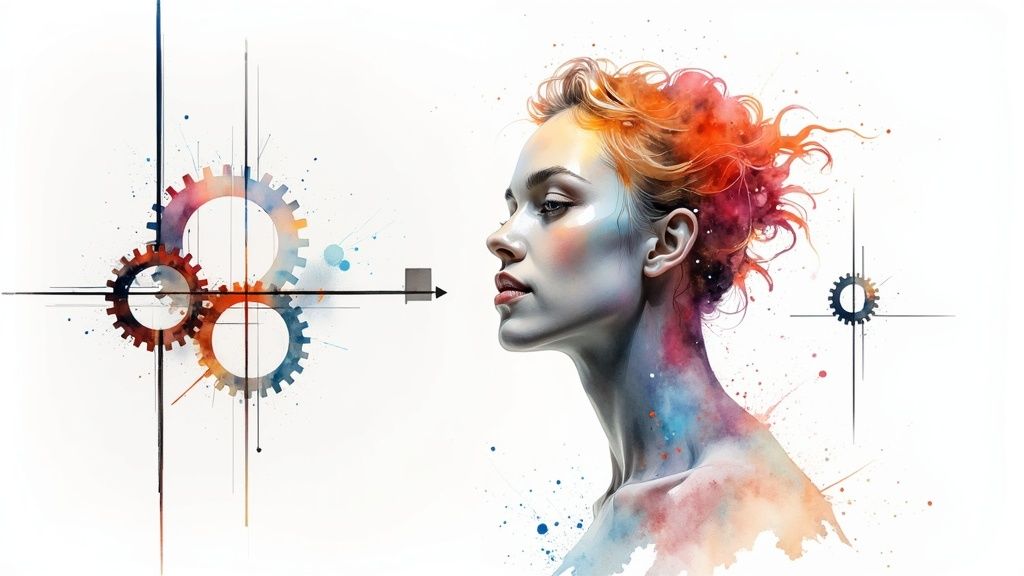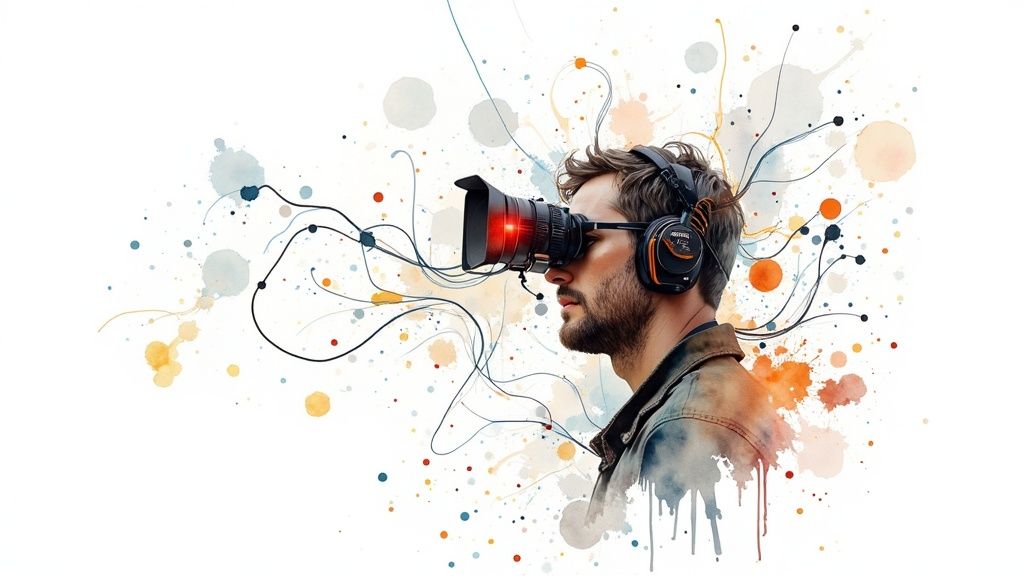The Evolution of Automated Video Creation

Automated video creation has evolved significantly. Early tools relied on basic templates and simple editing software, offering limited creative control. While useful for short, formulaic videos, these tools lacked the power to produce engaging, complex content. They primarily functioned as slideshow creators, assembling pre-existing images and music.
From Templates to AI
The arrival of artificial intelligence has revolutionized this field. Advanced AI algorithms are transforming video creation, moving beyond simply assembling assets to generating unique content.
- Script and voiceover creation
- Character animation
- Realistic video footage generation
- Personalized content at scale
This AI-driven personalization allows for maximum impact by tailoring messages to individual viewers. It represents a significant advancement in scalable video production.
Impact on Production
This evolution offers substantial benefits for brands. Traditional video production was resource-intensive, demanding significant time, budget, and specialized skills. Automated video creation tools lower these barriers.
Teams can now create more content more quickly, freeing up resources for strategy and creative direction. This allows for faster iteration, experimentation, and a higher return on investment. The growth of the AI video creation market underscores this value.
- Projected growth from USD 1,054.3 million in 2023 to USD 7,452.5 million by 2033.
- A CAGR of 21.6%.
- Up to 62% production time savings (approximately 8 days per month) for training videos.
- 75% of video marketers now use AI-assisted content creation tools.
For more statistics, Explore this topic further.
The Power of Streamlined Workflows
Streamlined workflows are another key advancement. Traditional video production involved multiple handoffs and bottlenecks. Automated platforms centralize these tasks.
Teams can collaborate on scripts, manage assets, edit videos, and distribute content within a single platform. This eliminates the need for multiple disconnected tools and streamlines the entire production lifecycle. The result is increased output and improved content quality and consistency.
Transforming Workflows With Automated Video Creation

Automated video creation is significantly changing how teams work. This shift impacts everything from production timelines and budgets to the structure of creative teams. Marketing teams, for instance, are producing more content in less time. Some are even doubling their output while cutting production time in half.
This increased efficiency leads to more flexible content strategies and faster responses to market changes. Naturally, these advancements raise questions about the larger impact on team dynamics and individual roles.
Evolving Roles, Not Eliminating Them
Automated video creation isn't about replacing creative professionals. It's about changing their roles. Instead of manual tasks, creatives can focus on high-level strategy, concept development, and brand storytelling. This shift allows for more fulfilling work and a greater impact on marketing strategy.
Automated tools also allow teams to experiment with new formats and styles. This leads to more innovative and engaging content, boosting a brand's creative output and reach. These advancements are powered by the underlying technology driving this change.
Generative AI in video creation transforms traditional production. It automates editing, animation, and voiceovers. AI-powered video creation tools can cut time and budget by up to 80% compared to traditional methods.
This efficiency has driven widespread adoption. 43% of respondents in a recent survey report that AI tools have replaced traditional video production in their organizations. AI can even analyze video clips to generate compelling social media content, boosting creativity by finding unique patterns and insights. As a result, the market for AI video production is projected to grow at a CAGR of 22.37% by 2028. For more statistics, see this article on generative AI video marketing.
Integrating Automated Tools Effectively
Successfully integrating automated video creation tools requires planning. Identifying potential resistance and addressing it proactively is key. This often involves educating team members on the benefits of automation. Showing how these tools enhance, rather than replace, their skills is crucial. Clear communication and training are essential for smooth adoption.
Choosing the right platform for your specific needs and workflow is also important. See this guide on how to create video using AI for more information.
Unexpected Benefits Beyond Efficiency
Automated video creation offers more than just efficiency. By streamlining production, these tools free up time and resources. This allows teams to focus on strategic initiatives and adopt a data-driven approach to content creation.
Teams can experiment, analyze results, and adjust strategies based on performance. This ultimately leads to stronger brand messaging, more targeted campaigns, and better ROI. It also creates a more adaptable and responsive content strategy.
Essential Features of Top-Tier Automated Video Platforms

Finding the perfect automated video creation platform can feel overwhelming. With so many options available, how do you choose the one that truly meets your needs? The key is to look beyond flashy marketing and focus on the features that deliver real value. This section will guide you through the essentials.
Must-Have Features for Efficient Automated Video Creation
The best platforms share a few core features: template libraries, asset management systems, and personalization engines. A robust template library provides pre-designed video formats for everything from product demos to social media content. This saves valuable time and allows your team to create professional-looking videos quickly.
A centralized asset management system keeps all your video components in one place. This simplifies collaboration and ensures everyone is working with the most up-to-date versions. Imagine having all your video clips, music, logos, and other assets readily available and organized.
Finally, personalization engines allow you to tailor videos to individual viewers. This personal touch boosts engagement and can significantly improve conversion rates.
Seamless Integrations for Streamlined Workflows
A truly valuable automated video platform integrates seamlessly with your existing tools. A disconnected platform creates extra work, not less. Look for integrations with your CRM (Hubspot), marketing automation platform (Marketo), and social media channels.
These integrations enable automated workflows and data-driven decisions. For example, a platform might pull customer data from your CRM to personalize video greetings or product recommendations. This level of integration can dramatically improve marketing effectiveness. Speaking of AI, you can delve deeper into its applications in ecommerce with this helpful resource: AI use cases.
Beyond the Basics: Advanced Features
Some platforms offer advanced capabilities like AI-powered scriptwriting tools, advanced analytics dashboards, and multi-language support. AI scriptwriting can help generate engaging narratives and overcome writer’s block. Advanced analytics offer valuable insights into viewer behavior, allowing you to continually optimize your videos. And multi-language support expands your reach to a global audience. To further explore AI's role in video creation, particularly for social media, check out our article on AI video editors for social media.
Before we wrap up, let’s look at a comparison of some leading automated video creation platforms. The table below highlights their key features, pricing, and best use cases.
To help you navigate the options, we've compiled a comparison table showcasing the strengths of different platforms:
Comparing Top Automated Video Creation Platforms
This table compares the key features, pricing models, and ideal use cases for leading automated video creation tools currently available in the market.
| Platform | Key Features | Best For | Price Range | Learning Curve |
|---|---|---|---|---|
| Synthesia | AI avatars, text-to-video, multi-language support | Creating explainer videos and marketing content | Varies based on usage | Easy |
| Pictory AI | Script-to-video, video editing, branding options | Social media videos and short-form content | Subscription-based | Easy to moderate |
| InVideo | Template library, video editing, collaboration tools | Businesses and marketers creating promotional videos | Subscription-based | Moderate |
| Steve.AI | AI-powered animation, character customization | Animated explainer videos and educational content | Varies based on usage | Moderate |
| Kapwing | Collaborative video editing, meme generation, social media tools | Content creators and social media managers | Free and paid plans | Easy to moderate |
This table offers a quick overview of various platforms and their strengths. Synthesia excels with its AI avatars, while Pictory AI shines in script-to-video creation. InVideo is a solid choice for businesses needing a comprehensive solution, while Steve.AI caters to animated content. Finally, Kapwing offers a versatile platform for social media content creation.
By carefully considering these essential features and exploring the options in the table, you can select the perfect automated video creation platform for your needs and achieve impactful results.
Scaling Personalization With Automated Video Creation

Personalization is crucial for maximizing the potential of automated video creation. Forget generic content; imagine creating thousands of video variations, each specifically designed for individual viewers. This is now achievable with current technology, and leading brands are already leveraging it effectively across various industries. Let's explore how this works.
Personalization In Action: Real-World Examples
Imagine a retailer sending personalized video messages to customers showcasing products based on their past purchases. Or a financial services company delivering investment advice tailored to individual portfolio performance. These are just a few examples of how businesses are using personalized video to boost engagement and conversion rates.
In the education sector, personalized video lessons can cater to individual student needs, leading to improved learning outcomes. These examples offer a glimpse into the potential of personalized video. This targeted approach creates a more impactful and relevant viewing experience.
Data Integration: The Engine of Personalization
Effective personalization relies on seamless data integration. Automated video creation platforms need to connect smoothly with existing customer databases, CRM systems, and marketing automation platforms. This integration allows videos to dynamically incorporate customer data like names, locations, purchase history, and more.
For instance, a video could address a customer by name or suggest a product they recently viewed. This dynamic integration enables personalized content at scale without sacrificing the viewing experience. It's essential for creating videos that genuinely feel personal, not just slightly altered templates.
The Growing AI Video Generator Market
The AI video generator market is experiencing rapid growth, fueled by the increasing demand for personalized, high-quality video content. In 2023, the market was valued at USD 554.9 million and is projected to expand at a CAGR of 19.9% through 2030. You can find more detailed statistics here. This growth demonstrates the increasing recognition of video's importance in modern marketing.
Practical Frameworks For Implementing Personalization
Implementing personalized video creation doesn't have to be overwhelming. There are several approaches, from simple to complex, that businesses can use.
-
Entry-Level Personalization: Begin by integrating basic customer data, such as names and locations, into video greetings or product recommendations. This simple step can yield quick results and showcase the value of personalization.
-
Segmented Personalization: Divide your audience into groups based on shared characteristics (e.g., demographics, purchase behavior) and create videos tailored to each segment's specific needs and interests.
-
Real-Time Behavioral Data: Advanced systems can use real-time behavioral data to personalize videos based on a viewer's current actions and preferences. This allows for highly targeted messaging and dynamic adjustments to content.
By selecting the right framework, businesses can significantly improve their marketing efforts and boost engagement using automated video creation. These tiered approaches enable businesses to gradually increase personalization as they gain experience and confidence. This careful approach ensures a smooth transition and maximizes the impact of each personalization initiative. Top performers are using these strategies to stand out in their respective markets, demonstrating the competitive edge that personalization offers.
Measuring What Matters in Automated Video Content
Moving beyond simple view counts is crucial for understanding the true impact of your automated video strategy. Leading brands are using analytics to optimize their approach, focusing on metrics tied to business outcomes. This data-driven approach allows for continuous improvement and ensures video content contributes to overall marketing success.
Beyond Vanity Metrics: Identifying Key Performance Indicators
While views offer a starting point, they don't tell the whole story. Engagement metrics, such as watch time, click-through rates, and comments, offer deeper insights into viewer interaction. For example, high watch time suggests videos resonate with your audience. A low click-through rate may indicate a weak call to action. This information helps create more effective videos.
It's also vital to connect video performance to revenue. This might involve tracking conversions, leads, or sales attributed to your video content. This demonstrates the return on investment (ROI) of your automated video efforts and justifies further investment.
A/B Testing: Optimizing for Success
A/B testing is a powerful tool for optimizing video content at scale. By testing different versions, you can identify what resonates best with your audience. This might involve experimenting with headlines, visuals, calls to action, or video lengths. The data provides valuable insights into viewer preferences.
For example, A/B test two video introductions to see which leads to higher watch time. Or, experiment with different end screens to optimize for conversions. This iterative process helps ensure videos are always improving.
The Rise of AI in Video Analytics
AI is transforming video analytics. It can automatically analyze large amounts of video data, identifying patterns and insights. This opens up new possibilities for optimizing video content and understanding viewer behavior. AI-powered video analytics is experiencing rapid growth, projected to reach USD 241.8 billion by 2033, with a CAGR of 32.5%. Find more detailed statistics here. Retail currently leads in adopting this technology.
Building a Unified View of Customer Behavior
Sophisticated marketing teams integrate video analytics across their entire marketing stack. This creates a unified view of customer behavior and content effectiveness. By combining video data with data from other sources, like CRM systems and marketing automation platforms, you can gain a deeper understanding of your audience. This holistic view allows for more personalized and targeted marketing campaigns.
Learn more in our article about the top AI implementations in media and marketing. By understanding these trends, you can better prepare your team and content strategy for the future of video marketing.
Building a robust measurement framework is crucial for success with automated video creation. By focusing on the right metrics, using A/B testing, and integrating data across your marketing stack, you can maximize the impact of your video content and achieve your business objectives.
Implementing Automated Video Creation Successfully
Successfully implementing automated video creation isn't just about picking the right software. It's a thoughtful process involving careful planning, getting your team on board, and having a crystal-clear understanding of your goals. This section dives into the critical elements that distinguish successful video automation projects from those that fall short.
Building a Roadmap for Implementation
Imagine building a house. You wouldn’t start without a blueprint. Creating a video automation strategy is no different. A practical roadmap is essential. This plan should detail the key phases, from setting your initial objectives to ongoing optimization and improvement.
-
Goal Setting: First, define your objectives. Are you trying to boost brand awareness, increase sales, or improve training materials? Having specific, measurable goals will keep your strategy focused and effective.
-
Platform Selection: Next, choose an automation platform that aligns with your needs and technical capabilities. Consider factors such as ease of use, integrations with your existing tools, and the features offered.
-
Team Training: Make sure your team knows how to use the chosen platform. This empowers them to create high-quality videos and tap into the platform's full potential.
-
Workflow Integration: Integrate the platform seamlessly into your existing workflows to minimize disruptions and make the transition as smooth as possible.
Overcoming Common Roadblocks
Even with the best planning, challenges will inevitably arise. A common obstacle is team resistance to new technology. Address this head-on by communicating the benefits of automation and providing adequate training and support. Make sure your team understands how this change will make their work easier, not harder.
Another hurdle is maintaining brand consistency as content production scales. Establish clear brand guidelines and select a platform with features that help enforce them. This might include template libraries, style guides, and built-in approval workflows.
Developing Governance Frameworks for Success
Effective governance ensures consistent quality and brand alignment across all your video content. A well-defined framework outlines roles, responsibilities, and approval processes. This clarity helps everyone understand who is responsible for which tasks.
For instance, the marketing manager might be responsible for the overall strategy, while content creators handle individual videos. A dedicated reviewer could then ensure all content adheres to brand guidelines before final approval and distribution.
To help visualize this process, let's look at a practical framework:
Introducing the "Automated Video Creation Implementation Framework," a phased approach designed to guide successful implementation within any organization:
| Phase | Key Activities | Success Metrics | Common Challenges | Solutions |
|---|---|---|---|---|
| Planning & Strategy | Define goals, target audience, and content strategy. Select a platform and allocate resources. | Clear objectives, defined metrics (e.g., increased engagement, lead generation). | Lack of clear goals, insufficient resources. | Conduct a thorough needs assessment, secure stakeholder buy-in, and develop a realistic budget. |
| Implementation & Training | Set up the chosen platform, train the team, and integrate it into existing workflows. Develop templates and style guides. | Platform adoption rate, team proficiency, consistent branding. | Resistance to new technology, integration challenges. | Provide comprehensive training and support, address concerns proactively, and ensure seamless integration with existing tools. |
| Content Creation & Distribution | Create videos, manage approvals, and distribute them across various channels. | Content performance (views, engagement, conversions), brand consistency. | Maintaining quality at scale, reaching the target audience effectively. | Implement quality control checks, optimize content for different channels, and leverage analytics to track performance. |
| Optimization & Refinement | Analyze results, gather feedback, and refine the process for continuous improvement. | Improved metrics, increased ROI, enhanced team efficiency. | Difficulty measuring impact, adapting to changing trends. | Track key performance indicators, stay updated on industry best practices, and be flexible to adjust the strategy as needed. |
This framework provides a structured approach to implementing automated video creation, from initial planning to ongoing optimization. By following these phases and focusing on the key activities, organizations can increase their chances of success.
Maximizing Your Investment in Automated Video Creation
By addressing these key aspects, you can transform automated video creation from a simple tool into a powerful competitive advantage. It's not just about producing more videos faster; it's about empowering your team to create compelling, impactful content that achieves your business goals. This strategic approach maximizes your return on investment and positions you for long-term success in the dynamic world of video marketing.
The Future of Automated Video Creation
Understanding the rapid advancements in automated video creation is crucial for staying competitive. This section explores emerging capabilities and how forward-thinking brands are adapting to the next generation of video creation technology.
Generative Video and Real-Time Personalization
Generative video, powered by AI, is transforming content creation. Imagine software that automatically generates video footage from text prompts or creates unique animations. This technology is evolving beyond basic templates, unlocking new creative possibilities.
This shift offers a new level of creative freedom for content creators. No longer confined by pre-existing templates, they can explore unique visuals and animations generated directly from their ideas.
Real-time personalization is another significant advancement. Videos can now dynamically adapt based on viewer behavior, offering a truly personalized experience. This could involve displaying targeted product recommendations or adjusting the narrative based on individual user preferences.
This personalized approach significantly boosts engagement and conversion rates, creating a more impactful viewing experience. By tailoring content to individual viewers, brands can foster stronger connections and drive more effective results.
Multimodal AI Systems: The Next Frontier
Multimodal AI systems are emerging, combining diverse data inputs like text, images, and audio. These systems offer a more holistic approach to video creation. Imagine creating a video simply by describing the concept, letting the AI handle the visuals, voiceover, and music.
This streamlined process has profound implications for content creation. It simplifies video production, making it accessible to a wider range of users and accelerating content development cycles.
Preparing for the Future of Video
These advancements present both exciting opportunities and new challenges. While technologies like generative video are already impacting content strategies, others are still in their early stages. Forward-thinking brands are preparing by:
- Investing in AI-powered video creation platforms: Choosing platforms that offer flexibility and integrate with emerging technologies is essential.
- Upskilling their teams: Training team members to use these new tools and understand the evolving video production landscape is critical.
- Developing flexible content strategies: Adapting to the rapid pace of technological change requires agility and a willingness to experiment.
Practical Steps to Take Today
You can take actionable steps today to prepare your organization for the future of automated video creation. Start by evaluating your current video production workflow and identifying areas where automation can provide the most benefit.
Next, explore leading automated video creation platforms like Aeon and experiment with their capabilities. Finally, cultivate a culture of continuous learning within your team, encouraging the exploration of new technologies and best practices.
By embracing these changes, you can position your organization to harness the power of automated video creation and stay ahead of the curve. Ready to transform your video creation process? Explore Aeon, the innovative video creation platform designed specifically for publishers. Aeon empowers you to effortlessly create engaging video content at scale, automating tasks from text-to-video conversion to social media optimization. Learn more about Aeon and its AI-driven capabilities.